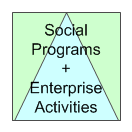 Social programs and business activities are one and the same. Nonprofits create Embedded Social Enterprises expressly for programmatic purposes. The enterprise activities are "embedded" within the organization's operations and social programs, and are central to its mission. Social programs are self-financed through enterprise activities and thus, the embedded social enterprise also functions as a sustainable program strategy.
Social programs and business activities are one and the same. Nonprofits create Embedded Social Enterprises expressly for programmatic purposes. The enterprise activities are "embedded" within the organization's operations and social programs, and are central to its mission. Social programs are self-financed through enterprise activities and thus, the embedded social enterprise also functions as a sustainable program strategy.
Due to their mission focus, most embedded social enterprises are usually structured as nonprofits to protect against mission drift, but may also be registered as for-profits depending on the legal environment.
The relationship between the business activities and the social programs are comprehensive: financial and social benefits are achieved simultaneously.
Embedded social enterprises are usually mission-centric; the business activities are central to the organization’s mission.
Embedded social enterprises are evident in operational models where:
- social and economic activities are unified;
- social mission is the central purpose to the business; and
- the target population (clients) is integral to the model as direct recipients of social services (beneficiaries) and either the market (customers), employees or owners of the enterprise.
The following operational models often take the form of embedded social enterprise:
- Entrepreneur Support Model
- Market Intermediary Model
- Employment Model
- Fee-for-Service Model
- Cooperative Model
- Market Linkage Model
Equal Exchange, an example of Embedded Social Enterprise
Equal Exchange (EE) is a US-based fair trade coffee company legally structured as an employee-owned cooperative and an example of embedded social enterprise. Equal Exchange purchases coffee beans and cocoa directly from small democratically-run farmer cooperatives in developing countries at fair trade prices--a guaranteed minimum price regardless of how low commodities markets fall. Equal Exchange pays a fixed rate of $1.26 and $1.41 per pound for organic certified coffee in contrast to $0.45 and $0.60 per pound that buyers pay on the commodities market1
. The embedded nature of Equal Exchange's social programs is evidenced in its business activities.
Marketing strategy--the company uses educational marketing campaigns to raise awareness of the positive social impact purchasing fair trade coffee has on low income farmers. Equal Exchange's coffee packaging contains information regarding the social benefits of fair-trade purchasing.
Distribution channels--in addition to retail outlets, products are sold through interfaith organizations and nonprofits that educate their constituents about fair trade coffee; then retain a margin on each sale to support their social activities.
Quality products--Equal Exchange assists farmers with sustainable techniques to promote ecological-friendly cultivation of coffee. The results yield higher product quality, environmental conservation, and 85% certified organic fair trade coffee for consumers.
Social Impact--EE works with twenty-five trade partners, farmer cooperatives, in twelve countries, and achieves social impact in two significant ways: supplier credit and fair trade premiums.
- Supplier credit--Most cooperative farmers in developing countries do not have access to bank financing, and those that do pay 25%-35% interest. The more available option is moneylenders, who charge up to 100% of the price of the loan. EE offers pre-harvest credit at interest rates of 8% to 9%, which enables farmers to produce high quality crops without losing margins on the sale of their products. In 2001 EE extended $700,000 in pre-harvest credit to 75% of farmers who requested loans.
- Fair trade premiums have substantial impact on the economic security of farmers and their families, increasing disposable income for food, education, healthcare, housing, etc. EE pays farmers more than twice the going rate on the commodities markets. In 2002, EE paid $1.2 million in fair trade premiums to cooperative farmers. In a protracted commodity price slump, which has occurred in recent years, these premiums literally save thousands of lives by warding off starvation occurring in many coffee growing regions.
Financial strategy and viability--Its for-profit legal status notwithstanding, Equal Exchange's financial motives are viability, not profit; in 2002 the company had $10.4 million in sales, which translated into $1.2 million in above market premiums for cooperative farmers, and funded marketing activities that raised the awareness of tens of thousands of consumers who bought fair trade products. The dollar figures are a monetary representation of Equal Exchange's sustainable mission accomplishment.
Equal Exchange is a mission-centric social enterprise; its business decisions and activities are central to accomplishing its mission: "To build long-term trade partnerships that are economically just and environmentally sound, to foster mutually beneficial relations between farmers and consumers and to demonstrate through our success the viability of worker-owned cooperatives and fair trade."
- 1Statistics from 2002
